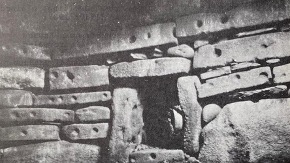- About MAA
- Membership
- MAA Publications
- Periodicals
- Blogs
- MAA Book Series
- MAA Press (an imprint of the AMS)
- MAA Notes
- MAA Reviews
- Mathematical Communication
- Information for Libraries
- Author Resources
- Advertise with MAA
- Meetings
- Competitions
- Programs
- Communities
- MAA Sections
- SIGMAA
- MAA Connect
- Students
- MAA Awards
- Awards Booklets
- Writing Awards
- Teaching Awards
- Service Awards
- Research Awards
- Lecture Awards
- Putnam Competition Individual and Team Winners
- D. E. Shaw Group AMC 8 Awards & Certificates
- Maryam Mirzakhani AMC 10 A Awards & Certificates
- Two Sigma AMC 10 B Awards & Certificates
- Jane Street AMC 12 A Awards & Certificates
- Akamai AMC 12 B Awards & Certificates
- High School Teachers
- News
You are here
Mathematical Mysteries of Rapa Nui with Classroom Activities: Conclusion
The questions that motivated the study that we undertook in connection with our trip to Rapa Nui were: Are the stone bases of the hare paengas elliptical? Did the Rapanui use the two-foci technique to lay out the hare paengas? And, is there any mathematics embedded in the Rongorongo script? We have answered the first question in the paper, thanks in part to confirmation provided by studying the imagery collected via drones and LiDAR technology. However, the answer to the second remains a mathematical mystery. Finding a lunar calendar description on some of the Rongorongo tablets provides a first step toward answering the third question, but much study remains to completely decipher the tablets.
One of the difficulties in answering the second question is the limited information available, since today only a small number of hare paenga survive. Métraux [1971, 195] believed that while hare paengas were common, stone-based hare paengas were not as common and were a reflection of wealth and status. Sadly, many of the hare paenga stone bases were reused later in the construction of walls, stone houses, and other dwellings. In the picture below, depicting the interior of an underground shelter called ana kionga or hare kionga, the reader can see how hare paenga bases were used to build an interior wall [McCoy 1976, 38].

Figure 17. Structure made from reused paenga stones depicted in McCoy 1976.
In 1916, Edwin Ferdon brought attention to certain resemblances between the floor plan of the Orongo houses and the hare paenga. The Orongo houses—built in the ceremonial village of Orongo at the southwestern tip of Rapa Nui—were permanent structures to which the high-ranking participants in the ceremonies could return each year. It is believed that forest depletion was the cause of the appearance of this type of stone house construction [McCoy 1976, 151].
It is quite frustrating to read how little attention and funds have been dedicated to the restoration and preservation of the archaeological sites on the island. Moreover, some of the restoration work has not been done in a way that preserves its authenticity [Ramirez 2016, 138–141]. In the 1960s, the construction of the first airport on the island used bulldozers that removed thousands of tons of topsoil containing archaeological material including moai pieces, house foundations, and a stone figure believed to include astronomical elements [Ramirez 2004, 493]. We encourage readers to join us in identifying and supporting organizations working to protect Rapa Nui’s archaeological and ecological heritage. Furthermore, we hope that some readers of this article might become—or teach the students who become—the archaeologists, anthropologists, and mathematicians who solve the mathematical mysteries of this unique island!
Ximena Catepillán (Millersville University), Cynthia Huffman (Pittsburg State University) and Scott Thuong (Pittsburg State University), "Mathematical Mysteries of Rapa Nui with Classroom Activities: Conclusion," Convergence (March 2021)




